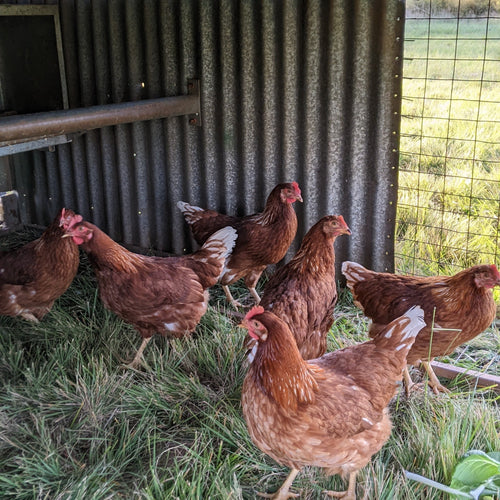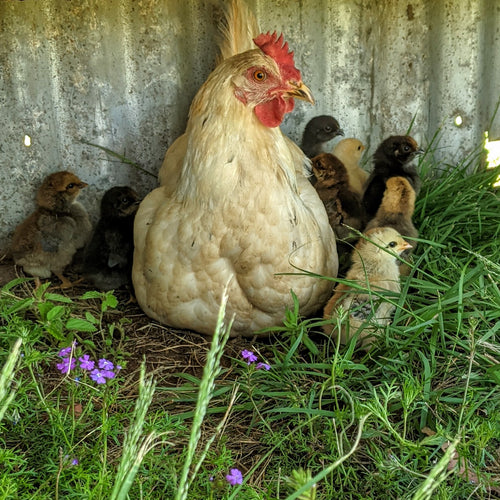Getting started with chickens - Sustainaburbia
Farmer Liz: Continuing my series of interviews with bloggers who keep chickens, I have a new blogger, actually a couple of bloggers, Adam and Amy, who I haven't featured previously. They are a family of three living on a 700 square metre suburban block near Fremantle, Western Australia. They are passionate about sustainability and write about our sustainable journey in their blog Sustainaburbia. Among topics of interest are gardening, preserving, ‘green’ technologies and cargo bikes. They write a bit about the chooks and record the number of eggs laid daily, so I thought they were perfect candidates to interview about getting started with chickens.
Adam and Amy: We currently have seven chooks, three oldish (5?) Australorps and four 18 month old Hi-line browns. The old girls are less productive these days so the new girls produce most of the eggs now. We use our chooks for egg production and in order to recycle scraps into manure which then goes in the compost.
FL: Where did you get your first chickens and how do you now replenish your flock?
A&A: Our first chooks were from a lady in Gidgegannup who sold us some lovely Plymouth Barred Rocks and Auracanas. We replenish the flock by buying pullets every now and again when egg production starts to slow down in older girls. We have tried unsuccessfully to put fertile eggs under broody chooks. We tend to have two breeds most of the time, we’ve also had Golden Laced Wyandottes in the past.
FL: Fixed chicken run or movable pen? Why?
A&A: We have a fixed pen. The pen is in the corner of our block and unfortunately doesn’t allow the chooks to roam through the garden. We haven’t figured out a way to integrate the chooks into the vege beds to clear out bugs, but we may build a chook tractor one day to do this. We have extremely fragile soils in WA which means we need to be careful not to disturb the soil too much.
FL: How do you integrate your chickens into the rest of your garden/farm?
A&A: Mainly through the use of soiled chook straw which goes into our hot compost.
FL: What is your biggest chicken challenge at the moment?
A&A: Probably whether to, how and when to get rid of older unproductive chooks. It seems a waste to feed chooks which aren’t laying and yet we are fond of our girls who have worked hard for quite a few years.
FL: What is the best thing about keeping chickens?
A&A: Fresh eggs! There’s simply no comparison between a freshly home laid egg and what you get at the supermarket. You can taste the sunshine we say…
FL: What is your advice to new chicken owners? What do know now that you wish you knew before you got chickens?
A&AL: 1) Think about the best location for a pen. It’s hard to move one once you realise it doesn’t get enough sun or is not in the right place to integrate chooks into the garden.
2) What breed? Do you want eggs, meat or both?
3) Net your pen in. For years we had crows pinching eggs and doves pinching grain. We haven’t looked back since we put the net on.
4) Make the hen house ‘walk in’ height. Ours is only one metre high which makes it really hard to clean out.
FL: What is your advice to people who would like to keep chickens in the suburbs?
A&A: Go for it. Chooks don’t need much space and they’re easy to care for. You can always get a neighbour to chook sit if you tell them to keep the eggs. Eggs are also a great thing to barter with, eg swap eggs for a friend or neighbour’s excess fruit and veg.
FL: Any advice for keeping chickens around children (or children around chickens!)?
If you can raise them from eggs/chicks the kids will have a closer bond with them I think. Also smaller breeds like bantams seem to get on better with children and are more attractive to them too.
How many chickens (and other fowl) do you keep, what breed and what do you use them for (meat, eggs, slug control etc)?
Adam and Amy: We currently have seven chooks, three oldish (5?) Australorps and four 18 month old Hi-line browns. The old girls are less productive these days so the new girls produce most of the eggs now. We use our chooks for egg production and in order to recycle scraps into manure which then goes in the compost.
FL: Where did you get your first chickens and how do you now replenish your flock?
A&A: Our first chooks were from a lady in Gidgegannup who sold us some lovely Plymouth Barred Rocks and Auracanas. We replenish the flock by buying pullets every now and again when egg production starts to slow down in older girls. We have tried unsuccessfully to put fertile eggs under broody chooks. We tend to have two breeds most of the time, we’ve also had Golden Laced Wyandottes in the past.
FL: Fixed chicken run or movable pen? Why?
A&A: We have a fixed pen. The pen is in the corner of our block and unfortunately doesn’t allow the chooks to roam through the garden. We haven’t figured out a way to integrate the chooks into the vege beds to clear out bugs, but we may build a chook tractor one day to do this. We have extremely fragile soils in WA which means we need to be careful not to disturb the soil too much.
FL: How do you integrate your chickens into the rest of your garden/farm?
A&A: Mainly through the use of soiled chook straw which goes into our hot compost.
FL: What is your biggest chicken challenge at the moment?
A&A: Probably whether to, how and when to get rid of older unproductive chooks. It seems a waste to feed chooks which aren’t laying and yet we are fond of our girls who have worked hard for quite a few years.
FL: What is the best thing about keeping chickens?
A&A: Fresh eggs! There’s simply no comparison between a freshly home laid egg and what you get at the supermarket. You can taste the sunshine we say…
A&AL: 1) Think about the best location for a pen. It’s hard to move one once you realise it doesn’t get enough sun or is not in the right place to integrate chooks into the garden.
2) What breed? Do you want eggs, meat or both?
3) Net your pen in. For years we had crows pinching eggs and doves pinching grain. We haven’t looked back since we put the net on.
4) Make the hen house ‘walk in’ height. Ours is only one metre high which makes it really hard to clean out.
FL: What is your advice to people who would like to keep chickens in the suburbs?
A&A: Go for it. Chooks don’t need much space and they’re easy to care for. You can always get a neighbour to chook sit if you tell them to keep the eggs. Eggs are also a great thing to barter with, eg swap eggs for a friend or neighbour’s excess fruit and veg.
FL: Any advice for keeping chickens around children (or children around chickens!)?
If you can raise them from eggs/chicks the kids will have a closer bond with them I think. Also smaller breeds like bantams seem to get on better with children and are more attractive to them too.
FL: Thanks so much for joining in on my series Adam and Amy! Its great to get another very positive perspective from the suburbs. Now if you have any questions or comments for Adam and Amy, please visit their blog, Sustainaburbia and let them know what you think.
By the way, my chicken eBook is now available if you want to know more about backyard chickens and using chicken tractors. More information over at the chicken tractor ebook blog. Or you can get it directly from my shop on Etsy (.pdf format), or Amazon Kindle or just send me an email eight.acres.liz {at} gmail.com.
or just send me an email eight.acres.liz {at} gmail.com.
What's the eBook about?
Chickens in a confined coop can end up living in an unpleasant dust-bowl, but allowing chickens to free-range can result in chickens getting into gardens and expose them to predators.
A movable cage or “chicken tractor” is the best of both options – the chickens are safe, have access to clean grass, fresh air and bugs. Feed costs are reduced, chickens are happier, and egg production increases.
But how do you build a chicken tractor? What aspects should be considered in designing and using a chicken tractor effectively? In this eBook I aim to explain how to make a chicken tractor work for you in your environment to meet your goals for keeping chickens.
I also list what I have learnt over 10 years of keeping chickens in tractors of various designs and sizes, from hatching chicks, through to butchering roosters.
Reviews of the Design and Use a Chicken Tractor
























Leave a comment